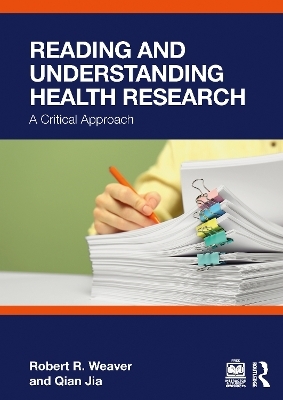
Reading and Understanding Health Research
Routledge (Verlag)
978-1-032-23009-2 (ISBN)
- Noch nicht erschienen (ca. März 2025)
- Versandkostenfrei
- Auch auf Rechnung
- Artikel merken
The book offers invaluable guidance by demystifying the structure and language of peer-reviewed research through different stages of reading—inspectional, analytical, and topical—to provide a structured approach to understanding and evaluating research design, methods, and findings. Through analytically reading each section of a research paper, readers can develop a critical appreciation of the evidence, helping them to identify both the strengths and limitations of any piece of research. This critical reading process is a crucial skill, fostering the ability to judiciously apply evidence to health practice, and encouraging a deep engagement with research to better inform health decisions.
Ideal reading for students across all health disciplines, whether undergraduate or postgraduate, it will also a valuable resource for health professionals seeking to enhance their skills in evidence-based practice and continuing professional development. Instructors can also access a range of online resources to support classroom use.
Robert R. Weaver earned his doctoral degree in the Sociology of Health and Illness from the University of Connecticut, US. He currently teaches research methods in the Department of Health and Exercise Science (School of Nursing and Health Professions) at Rowan University, US. Qian Jia earned her doctoral degree in Nutrition from the Texas A&M University, US, and is a Registered Dietitian. She currently teaches Interprofessional Healthcare Research and Graduate Nutrition Capstone courses in the College of Nursing and Health Professions at Immaculata University, US.
Preface. 1.Introduction: Reading Health Science. Part 1.Searching and Inspecting Article. 2.Finding Relevant Articles. 3.Inspection 1: Pigeonholing an Article by its Title. 4.Inspection 2: Assessing an Article’s Relevance. PART 2 Analytically Reading Primary Studies. 5.Ten (10) Questions for Analytically Reading Quantitative Studies. 6.Understanding Observational Designs. 7.Analytically reading observational studies. 8.Understanding Experimental Designs. 9.Analytically Reading Experimental Studies. 10.Qualitative Research Designs. 11.Analytically reading qualitative studies. Part 3.Understanding Review Studies and Practice Guidelines. 12.Understanding Narrative and Systematic Reviews. 13.Analyzing Systematic Reviews. 14.Evidence Review and Practice Guidelines. PART 4 Topical Reading, Evidence-Based Practice (EBP), and Professional Growth. 15.Topical Reading, EBP, and Professional Growth. Appendix A.Elementary Reading and Fundamental Terms. Appendix B.Potential Sources of Bias. Appendix C.Measures of Central Tendency and Dispersion. Appendix D.Confidence Intervals and Statistical Significance. Appendix E.Tests of Significance -- Chi squares, T-tests, and ANOVAs. Appendix F.Strength of Association.
| Erscheint lt. Verlag | 27.3.2025 |
|---|---|
| Zusatzinfo | 25 Tables, black and white; 23 Line drawings, black and white; 23 Illustrations, black and white |
| Verlagsort | London |
| Sprache | englisch |
| Maße | 174 x 246 mm |
| Themenwelt | Studium ► Querschnittsbereiche ► Epidemiologie / Med. Biometrie |
| Studium ► Querschnittsbereiche ► Prävention / Gesundheitsförderung | |
| ISBN-10 | 1-032-23009-6 / 1032230096 |
| ISBN-13 | 978-1-032-23009-2 / 9781032230092 |
| Zustand | Neuware |
| Informationen gemäß Produktsicherheitsverordnung (GPSR) | |
| Haben Sie eine Frage zum Produkt? |
aus dem Bereich


